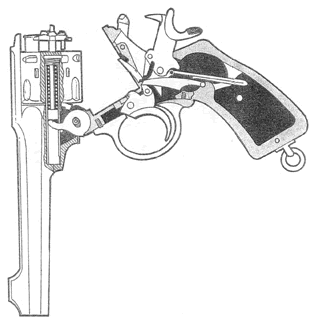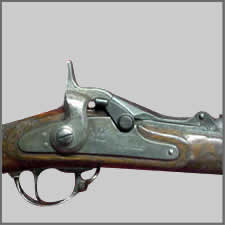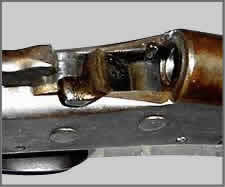Home | Glossary | Resources | Help | Contact Us | Course Map
Archival Notice
This is an archive page that is no longer being updated. It may contain outdated information and links may no longer function as originally intended.
Frame Design
It is important to consider an extension to the basic lock, stock, and barrel format of firearms prior to the cartridge era. Breech-loading arms ultimately required a new metal component that supported the lock/latch system and provided a central point for attaching all the parts. Although there are many terms used to define this component, the most common term is frame. In repeating arms, the term receiver is more common; the frame contains additional parts to receive cartridges and feed them into the firing chamber.
Latching the breech closed and opening it for access is a basic tenet of breechloader design. Early breechlocks required only the pressure of the shooters hand on a lever or other device to keep the breech from flying open during firing. As ammunition power increased, more robust locking and latching methods evolved.
Top Break Action
For low-power cartridges, a simple top break action was sufficient. This was derived from certain percussion breechloaders that used the same system. The barrel was hinged to a separate frame. The frame held the firing mechanism and the lock/latch system. Operating the latch withdrew the locking bolt from its engagement with the barrel, letting the barrel tip down (in some designs, the barrel pivoted to the side) for ready access to the breech. This system is commonly found today in single- and double-barrel shotguns and some rifles.
Falling Block Action
For the more powerful rifle cartridges of the post-Civil War era, a large breechblock installed perpendicular to the barrel proved popular and effective. The frame was slotted to permit a sturdy breechblock to slide down for loading and up for firing. The pattern of movement led to the name of the action type, the falling block. The most common U.S. military use of the falling blockfirst with percussion caps and later with true cartridges was the Sharps rifle. However, it was considered a secondary firearm. The Springfield Armory variations of the Allin conversion and new models of similar design (collectively known today as Trapdoor Springfields) remained the primary battle rifles of the U.S. military from the post-Civil War period until 1892.
Falling block actions were and continue to be fine, reliable mechanisms. However, some were bulky and others were not convertible to function as repeating firearms.
Rolling Block Action
Another single shot design that found favor with military customers was the rolling block action originated by Remington Arms. Its name describes the movement of the breechblock, which is pinned below the axis of the bore and rotates about one hundred degrees to expose the chamber for loading. A curved interior surface on the block connects with a matching surface on the hammer. When the hammer is cocked, the surfaces are fully disengaged, allowing the block to be opened. When the trigger is pulled, the two surfaces reengage to hold the breech closed for firing.
In breech design theory, the strongest actions are those whose support against the rearward thrust of the cartridge is as strong above the centerline of the cartridge as below. The rolling block action was simple and easy to operate, but not as strong as the falling block. In the rolling block design, the entire support against cartridge thrust is well below the centerline of the cartridge. Although, appropriate for low-power, black powder cartridges, the rolling block could flex and eventually loosen when operated with more modern cartridges. Conversely, the falling block design effectively balances upper and lower support.
Additional Online Courses
- What Every First Responding Officer Should Know About DNA Evidence
- Collecting DNA Evidence at Property Crime Scenes
- DNA – A Prosecutor’s Practice Notebook
- Crime Scene and DNA Basics
- Laboratory Safety Programs
- DNA Amplification
- Population Genetics and Statistics
- Non-STR DNA Markers: SNPs, Y-STRs, LCN and mtDNA
- Firearms Examiner Training
- Forensic DNA Education for Law Enforcement Decisionmakers
- What Every Investigator and Evidence Technician Should Know About DNA Evidence
- Principles of Forensic DNA for Officers of the Court
- Law 101: Legal Guide for the Forensic Expert
- Laboratory Orientation and Testing of Body Fluids and Tissues
- DNA Extraction and Quantitation
- STR Data Analysis and Interpretation
- Communication Skills, Report Writing, and Courtroom Testimony
- Español for Law Enforcement
- Amplified DNA Product Separation for Forensic Analysts





